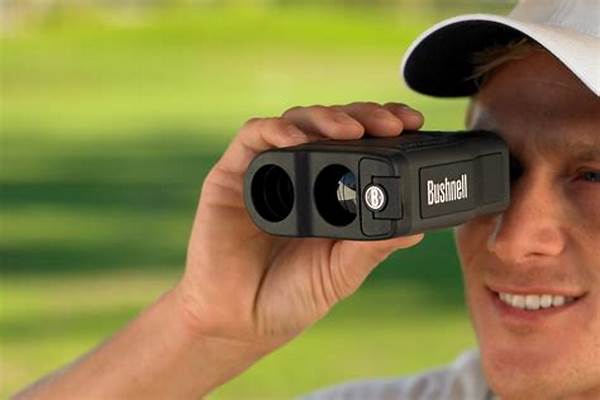Hey there, golf enthusiasts! Whether you’ve just started taking swings or you’re looking to up your game, understanding the tools of the trade is crucial. One gadget that’s increasingly becoming a staple for golfers—novices and pros alike—is the golf rangefinder. If phrases like “adjusted yardage” or “slope measurement” sound like jargon to your ears, don’t worry. You’re in the right place. Let’s break it down in this beginners guide to golf rangefinders, making it all simple and easy to digest.
Read Now : Top Golf Simulators For Less
Why Golf Rangefinders Matter
Alright, so why exactly should you care about golf rangefinders? Simply put, these devices can be the difference between a rough day on the course and an exceptional round. Imagine shooting an arrow without knowing how far the target is. Frustrating, right? A rangefinder, acting like that digital guru, accurately tells you the distance to various targets on the course. In the beginners guide to golf rangefinders, you’ll find they help you choose the right club and understand the landscape better. By doing so, they take the guesswork out of the game, giving you more confidence and precision with each swing. Whether you’re hitting the local course on weekends or aiming for a more competitive level of play, these nifty gadgets can empower your journey.
But hold on! Before you rush out to buy one, there’s a bit more to it. Several types of rangefinders are in the market, each offering different features. Some have GPS systems, while others provide laser-based measurements. Understanding your specific needs and how these devices can cater to them will ensure you choose the right one. This beginners guide to golf rangefinders can be your roadmap, helping you navigate through the plethora of options and find a device that matches your style and requirements.
Factors to Consider When Choosing Your Rangefinder
1. Accuracy: In this beginners guide to golf rangefinders, accuracy is key. The main reason golfers adore rangefinders is for their precise distance measurements, helping to optimize every shot.
2. Ease of Use: If it takes longer to set up your rangefinder than hit the ball, it’s a no-go. Devices that are user-friendly are best for newcomers.
3. Features: The best investment is one that grows with you. Consider rangefinders that may have additional features like slope calculation, which could be useful as you advance.
4. Size and Weight: You don’t want anything too bulky or heavy. The ideal rangefinder fits snugly in your hand or pocket, making it easy to bring along on the course.
5. Budget: As much as we all want that top-tier tech, staying within a reasonable budget keeps everyone happy. Thankfully, our beginners guide to golf rangefinders explores options across various price ranges.
Using Golf Rangefinders Effectively
Jumping into the realm of rangefinders can feel a bit intimidating, but it’s not rocket science. Firstly, familiarize yourself with the manual of your chosen device—it’s your new best friend. Read it over and don’t hesitate to play around with the settings. This beginners guide to golf rangefinders advises that practice makes perfect. Head out to a practice range, and take small steps to get a feel of how it reads distances.
Read Now : Best Practices In Golf Footage Stabilization
Start by pointing it at targets you’re familiar with, like flags or markers, and compare its readings with your club’s hit distance. Once you feel more confident, venture into more challenging terrains. Don’t rush your learning curve; take gradual steps in mastering its use. Patience and practice will have you navigating ranges in no time. Thus, making the most out of this beginners guide to golf rangefinders.
Common Pitfalls and How to Avoid Them
Practical Tips from a Beginners Guide to Golf Rangefinders
So, you’re armed with a new gadget, ready to conquer the golf course distance by distance. But, let’s sprinkle in some practicality from our beginners guide to golf rangefinders. A crucial tip? Ensure your hands are steady as a rock when using your rangefinder. Shaky hands can give you inaccurate readings, which is something you definitely don’t want mid-game. Another vital point: don’t fully rely on technology. It’s there to support and enhance your skills, not replace your on-field judgment. Always integrate rangefinder data with your natural golfing instincts for the best results.
When purchasing your rangefinder, consider what features align with your golfing goals. Do you need something simple for casual games, or do you prefer advanced tech for heightened precision? Deciding on this before purchase helps streamline your choices. Remember, in this sport, clarity is key—not just on the course, but also in decision-making. Lastly, practice balance. Use your rangefinder to assist in strategy but keep practicing good old-fashioned estimation. Remember, today’s tech-savvy helps may be tomorrow’s classics, and patience in learning its ropes is vital. Cheers to exciting games ahead, with your loyal rangefinder by your side!
Wrapping Up: A Beginners Guide to Golf Rangefinders
As we’ve explored in this beginners guide to golf rangefinders, they are essential in crafting a more enjoyable and precision-based golfing experience. It’s fantastic to see how technology can make such a difference, turning what might seem like complex math into simple science. Just remember that this tool is to guide you, not dictate your every move.
The journey of integrating a rangefinder into your game is just beginning. Invest time learning its ins and outs, handling it with care, and understanding its readings. There will undoubtedly be trial and error, surprises, and learning curves. But each step, and every yard calculated, brings more excitement and strategy to your golfing days. As you forge ahead, try to relish the learning process as much as the result. Through this beginners guide to golf rangefinders, you’re now equipped to not just transition your game but transform it. Happy golfing!
